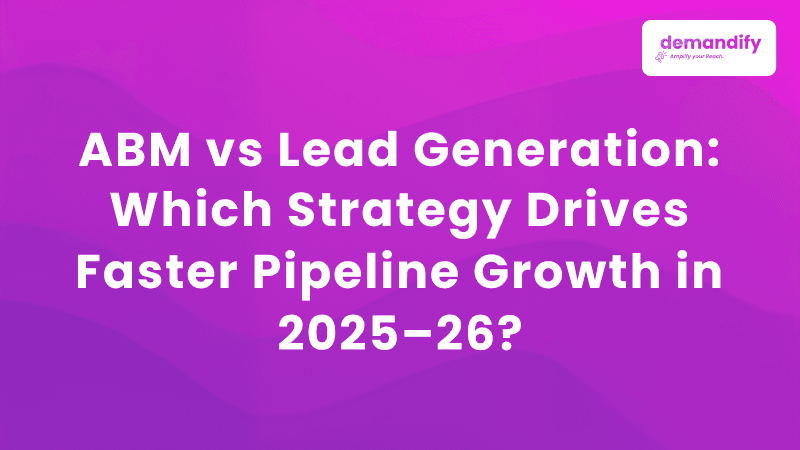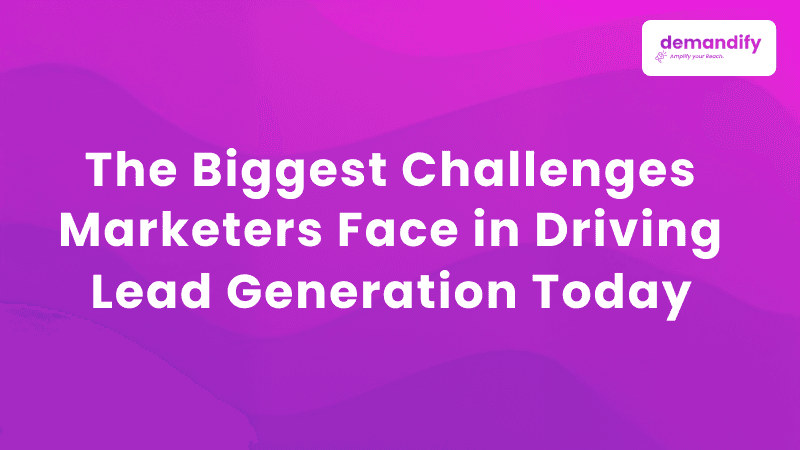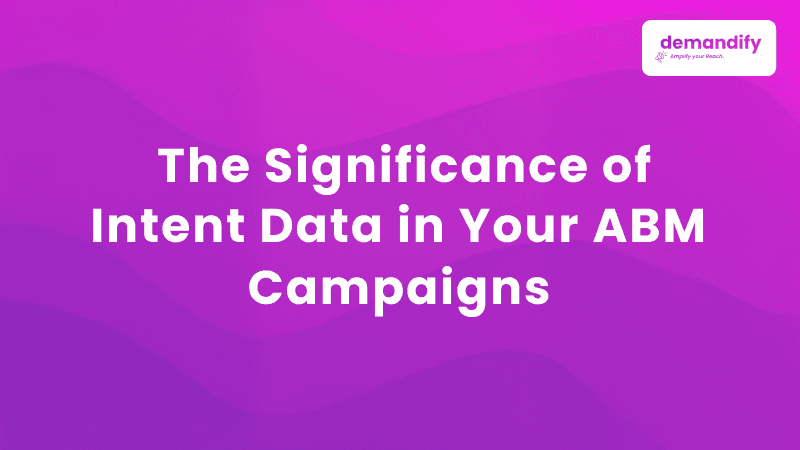ABM vs Lead Generation: Which Strategy Drives Faster Pipeline Growth in 2025–26?

In just three years, companies have transformed B2B purchasing—more than they had in the previous ten years. Decision-makers are increasingly relying on digital research for information. The size of the buying committee has grown from 5 to 7 members to 10 to 14, and buyers now expect a personalized experience, even if they haven't yet contacted the sales team. With the competition becoming fiercer, the real question that modern marketers have to answer is no longer "How do we get more leads?" but "How do we get the right leads and convert them faster?"
This is the point where the debate becomes heated: ABM vs Lead Generation.
Both are effective. Both contribute to the pipeline. However, in 2025 - 26, one strategy can be far superior to another depending on your deal size, buyer maturity, and revenue goals. What's more? The best B2B teams right now are using both strategies simultaneously through ABM lead generation, which is a combination of precision targeting and multi, channel scale.
We can look at each model separately to understand how they work and which one can deliver the fastest, most predictable pipeline growth.

What Is Lead Generation in B2B?
Lead generation involves the strategies a business applies to draw, keep, and convert customer prospects who are willing to make a purchase of a product or service. The main emphasis is on producing many leads at the initial stage of the funnel which enterprises can then utilize for accessing more extensive groups of people as well as for sustaining the flow of their sales pipeline at the very beginning regularly.
Such a method works wonderfully well for firms that are looking to increase their share in the market or are aiming at the middle market segments.
How Lead Generation Works
Lead generation depends heavily on multi, channel strategies:
- Inbound: SEO, blogs, landing pages, gated content
- Paid: LinkedIn ads, search ads, programmatic campaigns
- Content Syndication: Third, party networks distributing content to ICP, aligned audiences
- Email Nurturing & Drip Flows
- Events & Webinars
It all comes down to one thing: generating a continuous flow of leads, qualifying them, and getting them engaged at an early stage.
Pros and Cons of Lead Generation
Pros
- Rapid expansion at the top of the funnel.
- Lower cost to obtain leads.
- Simple scaling is possible in different industries.
- Contributes to building recognition of the brand during its early phases.
Cons
- The level of qualification is less accurate.
- The sales team can be flooded with unready.
- Requires Longer Nurturing Cycles.
- Less suitable for enterprise ACV deals.
What Is Account-Based Marketing (ABM) in B2B?
Account Based Marketing changes the local work by putting the main focus firstly on the qualitative aspects instead of the quantitative ones. ABM, as a method, selects only the most valuable accounts and thus, makes personalized experiences especially for their specific problems, buying committees, and even for the latest signals of their intentions, and this is contrary to traditional marketing which targets everyone.
In 2025 - 26, the use of A/B testing has evolved further through AI, powered insights, predictive scoring, and live intent information, thus becoming a commanding strategy for enterprise B2B companies with a large client base.
Common ABM Tactics Used by High-Growth B2B Teams
- Personalized 1:1 and 1:Few campaigns
- Use of intent, based targeting and account scoring
- Engagement with multi, stakeholder buying committee
- Landing pages, assets, and ads customized
- Coordination between sales + marketing
- Also, brands use retargeting, email sequences, and programmatic account ads to deliver these messages.
These methods substantially increase the effectiveness of ABM lead generation, allowing brands to get in touch with the correct accounts at the exact time.
Pros and Cons of ABM
Pros
- Increased pipeline quality and win rates
- Stronger coordination between sales and marketing drives better results.
- Reduced sales cycles through intent, driven targeting
- Primarily applicable to enterprise and high, ACV deals
Cons
- Requires greater depth of insights, data, and improved coordination.
- Needs more substantial resources to run effectively.
- Is not suitable for companies with very large TAMs
- Account and intent data need to be accurate
ABM vs Lead Generation: Key Differences
- Targeting Approach: Lead gen is more of a broad approach; ABM is a highly targeted approach for a selected few accounts.
- Volume vs Precision: Lead gen is mainly volume, driven; ABM is a precision, driven activity.
- Personalization Level: Lead gen relies on general messaging; ABM employs personalized, account, specific content.
- Data & Intent Usage: Lead gen operates with basic data; ABM relies on deep intent signals and predictive scoring.
- Sales Alignment: Lead gen is predominantly marketing, led; ABM needs a close collaboration between sales and marketing.
- Pipeline Impact: Lead gen increases early funnel volume; ABM is able to accelerate mid, funnel velocity and win rates.
- Budget Allocation: Lead gen is a strategy that spends money broadly; ABM is an account where money is invested heavily, but only in a few, that have the highest potential.
- Deal Complexity: Lead gen is good for mid, market deals; ABM is the best option for enterprise buying committees.
ABM vs Lead Generation: Similarities
- Both are designed to increase pipeline and revenue.
- Both use content and consistent messaging as their main tools.
- Both get more benefits when they have clear intent, insights, and ICP.
- Both will produce better results if there is a strong sales handoff.
- Both are instrumental in sustainable customer acquisition and brand awareness.
Contemporary B2B decision, makers integrate, rather than pick, one or the other by employing ABM lead generation services that harmonise scale with accuracy.
ABM or Lead Generation: When to Use Which?
Indicate Lead Generation as your choice if:
- You require a rapid growth of TOFU
- Your ACV is of low or mid, market range
- You are going to new regions to broaden your business
- You want to quickly raise your brand awareness
Select ABM if:
- You are the supplier of enterprise SaaS or high, ACV solutions
- Your deals include 7, 14 stakeholders
- You need higher, quality opportunities (not more leads)
- Your sales cycle lasts from 3 to 12+ months
If you want a Hybrid ABM Lead Generation Model, consider:
- Having a predictable, revenue, ready pipeline as a goal
- Needing both reach + personalization
- Being dependent on intent, based targeting
- Wishing to speed up the change of stages at all funnel levels
The majority of best, performing B2B brands in 2025 - 26 are making a transition precisely in this way, they are choosing ABM lead generation services that integrate targeting, personalization, and multi, channel execution.
What’s Best for B2B in 2025–26: ABM or Lead Generation?
Top, performing companies are not choosing one side only. They are mixing the best features of both.
The result of this combination is a functioning revenue engine that looks like this:
Lead Generation for Scale + ABM for Precision → Faster, Higher, Quality Pipeline.
- Lead generation is the engine that drives awareness and thus new leads are brought into the funnel.
- ABM is the process that identifies, prioritises, and accelerates those accounts which have the highest probability of conversion.
As a result, they create a predictable pipeline machine tailored to 2025–26 buying behaviour.
Such a hybrid model is precisely the reason why demand generation teams are progressively turning to ABM lead generation as their main growth play-book.
Conclusion
In the next two years, B2B brands will measure themselves not by the number of leads in their lists, but by how quickly and how well they convert pipeline opportunities. Lead generation will still be the main tool for quick reach and awareness. Still, ABM will be the one to dominate when it comes to getting real buyers with real purchase intent involved.
The brands winning 2025 - 26 will be those that strategically combine both tactics-
- By using lead generation to extend reach.
- By using ABM to deepen the relationship and focus on the most relevant.
- By using ABM lead generation services to integrate strategy, intent, and execution into one predictable revenue engine.
If you are looking for pipeline growth that is sustainable, engagement at the enterprise level, and higher win rates, then the smartest decision would be to build a hybrid model rather than just choosing ABM Lead Generation that gives you the best of both.
For a comprehensive introduction to Account-Based Marketing and Lead Generation, see our earlier blog post linked here.
https://demandifymedia.com/abm-or-lead-generation-which-is-better
Recent Posts

Effective ROI Strategies for B2B Lead Generation Campaigns

The Biggest Challenges Marketers Face in Driving Lead Generation Today

The Significance of Intent Data in Your ABM Campaigns

The Complete Guide to Effective EDM Blasts

How Content Syndication Builds Brand Awareness and Leads

Enhancing Customer Experience with Clear Call-Back Consent
Frequently Asked Questions
A larger buying committee favours ABM because it allows personalized targeting of multiple stakeholders within an account. Lead generation works best when buying decisions involve fewer stakeholders.
High ACV or enterprise deals benefit from ABM due to personalized engagement and longer sales cycles. Mid-market deals often rely on lead generation for volume and rapid top-of-funnel growth.
Longer, complex sales cycles favours ABM due to its targeted nurturing approach; shorter cycles suit lead generation’s rapid volume-driven methodology.
Start by identifying high-value accounts, layering intent data, coordinating with sales teams, and running small-scale ABM pilots alongside ongoing lead generation campaigns.
ABM content is highly personalized for individual accounts or personas, whereas lead generation content is broader, aiming to attract and educate a wider audience.
